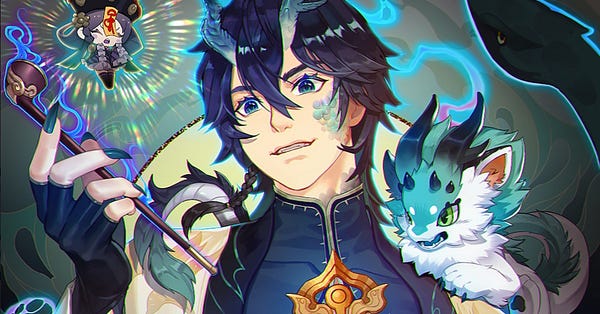[Thoughts #165] Limit Break's Programmable Royalties Contract
PLUS: 📃 Hacker Haikus, Azuki's Hilumia
It’s not raining today! Let’s get it 😎
Limit Break’s Programmable Royalties Contract
A couple days ago, Limit Break revealed details around their Programmable Royalties contract.
As a quick refresher, this is the Limit Break that will be airing a Super Bowl ad with a live free mint. If you see family or friends (or yourself 😉) holding their phones up during commercial breaks ready to scan something, it might be for this:


Limit Break’s CEO, Gabriel Leydon has been teasing the royalties announcement for about a month:

The announcement came in the form of a 28-part tweet thread and a Medium blog post. The Github repo and documentation is here. Here’s the TLDR:
The smart contract is opt-in (for the holder) and backwards-compatible
The royalties will be enforceable at the individual token level, not at the contract or marketplace level
One of the primary use cases of this contract is a ‘Stake to X’ functionality:
Stake to reveal
Stake to earn rewards (airdrops, claims, community rewards)
Stake to rent
Stake to list at a minimum floor price
Stake to engage (participating in questing or crafting in a Web3 game)
Royalty sharing has the potential become dynamic:
Affiliates (eg: influencers) can earn a portion of royalties if they are credited with a sale
Minters can earn a portion of royalties on future sales of that token
Holders can earn X% of royalties based on how long they held those tokens
Holders can earn X% of royalties on future sales for a specified amount of time
Limit Break is working with with marketplaces to establish the ‘Minimum Floor Operator’ as a marketplace standard
The Limit Break and DigiDaigaku teams are still planning around how they will implement the contract for their own collections
I agree Internet Grandma, and I’m not going to pretend like I know what’s going to happen.
There are a lot of known unknowns and unknown unknowns with this new contract, and I applaud the Limit Break team for open-sourcing this for other developers to explore and experiment with.
As I read through the thread and blog post a couple times, I believe some themes will emerge:
User Experience will be key for mass adoption of Stake to X
The ‘Stake to X’ parameter holds a lot of potential, but can get confusing quickly. The best products will have to consider how they will implement this while providing a simple user experience on the front-end. Mass adoption will not come if everything is done through a smart contract or a confusing interface.
Royalty sharing will influence user behavior for better and worse
If minters can earn a portion of future royalties, will that encourage mass botting for all collections? These actors would double dip in hopes of selling for a profit as well as create a passive source of income through earning a share of future secondary royalties.
If affiliates can take a cut of royalties, will we start seeing influencers promote projects with ulterior motives that their audiences are unaware of?
In the past, some influencers talked about projects and sold their NFTs in those projects when the price increased. In this new paradigm, it may be possible they won’t need to hold those NFTs and focus on driving volume instead.
Minimum Floor Operator will go through a ‘test and learn’ phase
Limit Break provided a couple examples where establishing a floor price would make sense:
Reinforcing the value of a in-game item that is ultra-rare
Artists reinforcing the value of their work. Eg: If their physical work sells for thousands, ideally their digital work should not be selling for a few dollars
The examples presented are valid, but it also creates a layer of centralization that did not previously exist. Additionally, Web3 and NFT consumers are still a young and evolving bunch.
Because of this, I imagine there will be more failures before there are successes, and a lot of discourse in the Web3 ecosystem around this if adoption grows.
Some (sorta unreasonable) examples to illustrate my point:
A new collection launches with a mint price of 0.1 ETH (~$140) and sets a minimum floor price of 1 ETH (~$1,400). There are no buyers because the project has not justified the minimum floor price. The team disappears and the minters are trapping holding the bag.
A physical artist launches a new 1,000 piece digital collection and sets a minimum floor price at the level of their physical sales. However, the digital collector base is different than the physical collector base and maybe the supply of their physical work is more unique and limited than their digital work.
A Web3 game sets a minimum floor price of 10 ETH for legendary items. As more items in the game are introduced, holders of the legendary items are unable to sell their legendary items to purchase other items to help them progress through the game.
In the above scenarios, I imagine the creators would be thoughtful about the minimum floor price they set and adjust accordingly. However, there may be creators that are adamant about what they believe the value of those tokens are while holders disagree with the decision.
On the other hand, I can see this minimum floor operator working as intended as a form of technical reinforcement towards the value of the token.
Chris Cantino sums up my sentiment well:

I’m curious to see how this will be best implemented what public response will be.
Hacker Haikus
Yesterday a friend send me an interesting collection that incorporated a text to mint mechanic: Hacker Haikus
Prospective minters would text the number and it would reply with a link to mint a generative haiku. By the time I texted the number, the service was down as it was probably overloaded with a bunch of eager participants. Fortunately my buddy shared a screenshot of what the text reply looked like:
I’m sure the text to mint mechanic has been done plenty of times before, but this project got TPan’s brain thinking.
Similar to Limit Break’s ‘stake to X’ mechanic and the ‘X to earn’ mechanics, I think we’re going to see more ‘X to mint’ mechanics.
There may be different variations of this to create viral amplification. As an example, replace the prize below with getting on an allow list and at another tier of actions to get on the allowlist to mint 2 instead of 1.
There’s another convenient example of this as BAYC announced details for part 1 of “MDvMM”, a skill-based ‘play to mint’ game yesterday.


I won’t get into the details since I’m sure every other newsletter will get into it. Point is you need to play to mint.
Engagement is the name of the game and minting may require more than a few mouse clicks in the future.
Azuki’s Hilumia
Oh boy, another Azuki segment and I’m still not part of the community 😂
Today marks the 1 year anniversary of Azuki and the team made sure it memorable by announcing Hilumia.

More will be shared in due time, but it’s clear that the community is excited.

There are plenty of easter eggs and hints in the Hilumia reveal. For example, it seems like MODA will be a gallery to showcase art from the community.
Is Ember Square going to be the online shop for digital and physical goods? The team has already created Collector Profiles which may compliment this.
The map also includes Garden Express, an evergreen and approachable way to submit feedback, suggestions, and ideas. It actually makes me want to type something.
World class world building, you love to see it. Bravo 👏
See you next Tuesday!










